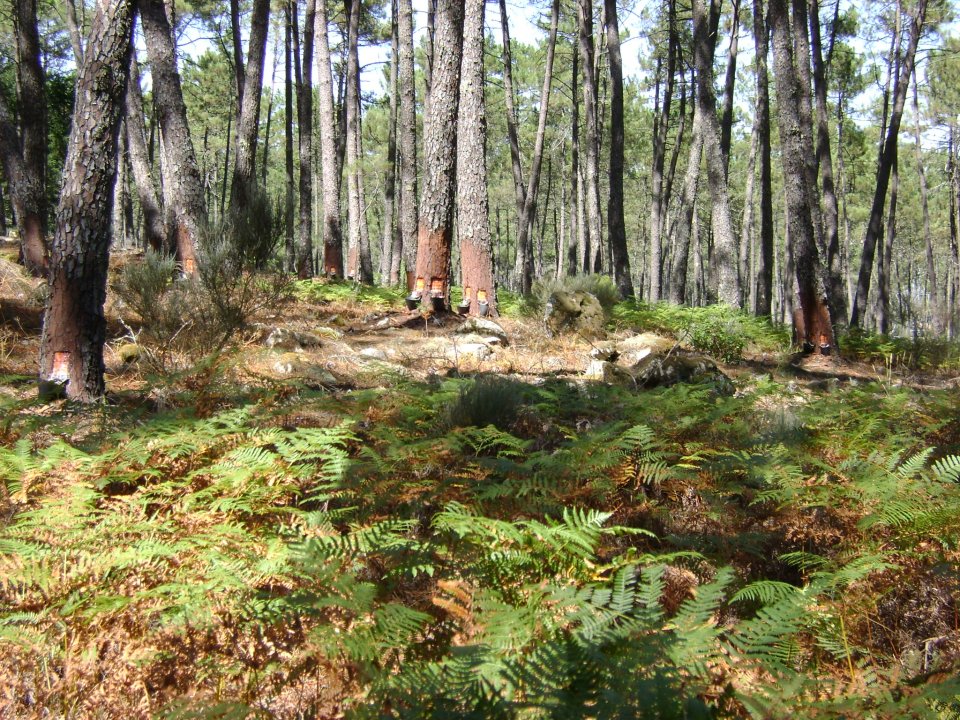
In Portugal, traditionally, the maritime pine is the species exploited to obtain resin. The silvicultural models used assume timber as the main product and resin as the secondary product, this being a periodic and annual source of income for the owner. The description of silvicultural models that make timber and resin exploitation compatible is essential and should be based on knowledge.
The silvicultural model defines the set of operations to be carried out in the forest stand, from the installation to the felling of the trees, which, in the case of stands exploited for timber, coincides with obtaining the main product. In a stand managed simultaneously to obtain timber (main product) and resin (secondary product), it is necessary to know the effects that the practice of resin tapping has on tree growth and wood characteristics.
- Influence of stand density in resin yield: there is no significant difference in stands with high and low densities; stands with low densities have more resin yield/tree - Resimprove Project.
- Tree shape is affected by stand density: low stand density - large tree diameters and (initial) higher heights; large crown ratios - Pedrico (2019).
- Influence of resin tapping on tree diameter growth: literature is not consensual - negative effect - Palma (2007); no effect - Rodríguez-Garcia et al (2015).
- Influence of climatic conditions on resin yield: there is a positive relationship between resin yield and solar radiation, potential evapotranspiration, mean temperature, and tree face exposition - Pereira (2015), Rodríguez-Garcia (2016).
The need to install a network of resin permanent plots to cover several situations of resin yield, local exposition, and density of stands and to define classes or regions of resin productivity as well as silvicultural models for stands exploited for timber and resin or resin only. The definition of these models should take into account the risks associated with the Mediterranean region forest, including approaches to forest fire prevention.
The knowledge of the factors that influence the amount of resin produced per tree and the impact that the practice of resin tapping has on the characteristics and development of the tree and the stand, enables the definition of solid and sustainable silvicultural models. Identifying the "really" important factors and the way they influence each other can result in a great diversity of situations and in the definition of a large number of silvicultural models.
Once the knowledge gaps and factors influencing resin production have been identified, it is essential (a) to install a network of permanent plots, based on well-defined and uniform protocols, to monitor resin production in a range of situations and (b) to install specific trials, based on experimental design, to study and analyze the influence of the factors identified as determinants.
Paula Soares, paulasoares@isa.ulisboa.pt
Further information
Resimprove project:
http://www.giff.pt/website/resimprove.php
Palma AMV, 2007. Capacidade produtiva de resina do pinheiro bravo: breve panorâmica do sector resineiro em Portugal. Dissertação para Investigador Auxiliar, Instituto Nacional de Recursos Biológicos (INRB), Estação Florestal Nacional (EFN), Oeiras.
Pedrico R, 2019. Efeito do compasso à plantação no desenvolvimento de povoamentos de pinheiro bravo. MSc Thesis in Forestry and Natural Resources Engineering. ISA, Universidade de Lisboa, Lisboa.
Pereira JM, 2015. Estimativa do potencial produtivo de resina em pinheiro-bravo no concelho de Castro Daire. MSc Thesis in Forestry and Natural Resources Engineering. ISA, Universidade de Lisboa, Lisboa.
Rodríguez-Garcia A, 2016. Factores anatómicos, dendrométricos y climáticos implicados en la producción de resina de Pinus pinaster Ait.:aplicación a la mejora de los métodos de resinación. PhD Thesis, Escuela Técnica Superior de Ingenieros de Montes, Universidad Politécnica de Madrid, Madrid.
Rodríguez-García A, Martína JA, López R, Mutkeb S, Pinillos F, Gil L, 2015. Influence of climate variables on resin yield and secretory structures in tapped Pinus pinaster Ait. in central Spain. Agricultural and Forest Meteorology 202, 83–93.
Credit: J Pereira
Maritime pine permanent plot Credit: P Soares
